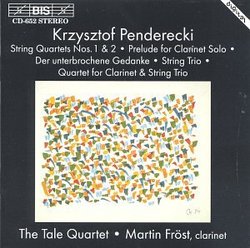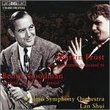| All Artists: Krzysztof Penderecki, Tale Quartet Title: Penderecki: Music For Clarinet & String Quartet Members Wishing: 0 Total Copies: 0 Label: Bis Release Date: 10/14/1994 Album Type: Import Genre: Classical Styles: Chamber Music, Historical Periods, Classical (c.1770-1830), Instruments, Reeds & Winds Number of Discs: 1 SwapaCD Credits: 1 UPC: 789368013821 |
Search - Krzysztof Penderecki, Tale Quartet :: Penderecki: Music For Clarinet & String Quartet
 | Krzysztof Penderecki, Tale Quartet Penderecki: Music For Clarinet & String Quartet Genre: Classical
|
Larger Image |
CD DetailsSimilar CDs
|
CD ReviewsFrom early Penderecki to late-Krenek - shouldn't it have bee Discophage | France | 01/05/2009 (4 out of 5 stars) "I am among those who lament the evolution of Penderecki, from a young, daring, inventive firebrand in the late 1950s and 1960s, to a conservative and clichéd composer, an evolution announced in the earlier works but confirmed with the Violin Concerto written for Isaac Stern in 1976. The present disc is a good document of that evolution.
The 1st SQ dates from 1960, the period of his seminal Threnody to the Memory of the Victims of Hiroshima. It is an essay in color and tone production, developing various effects of struck or plucked strings and other unusual techniques like striking the strings or sound-board with the hand. The 2nd Quartet from 1968 plays more on various unusual techniques of bow brushing the strings. In both, Penderecki goes not for melody but for color and timbre. They are sonic landscapes. They are also highly dramatic, evocative and effective. Both are short and compact: 6:42 and 10:11 with the Tale Quartet. The later works, starting with the 2-minute long "Der unterbrochene Gedanke" (The Interrupted Thought) for String Quartet from 1988, sound as if they could have been written by late Krenek. Now Krenek evolved from young Krenek - e.g., Schoenberg and Bartok influences - to late Krenek - not extraordinarily cutting edge, but angular, expressionistic, contrapuntal, with the early influences all digested. That trajectory I find much more laudable than going from young Penderecki to late Krenek. Strange thing with music: if someone wrote today a 42nd Symphony of Mozart, it may sound as good as the 42nd Mozart might have written, it'd still be a pastiche. Music has moved on, and like it or not, every contemporary composer is the heir and recipient of the complete history of music: writing music today is not just about writing something beautiful "in the manner of", it is writing music with the knowledge and conscience of all the music that has been written before, and going one step further, inventing a kind of beauty that has not been explored before. So when Krenek composes music of Krenek, I can think: "fine, I know where it comes from and where it has arrived, and there was a forward-moving trajectory here". But when Penderecki writes the music of Krenek, it is a backward-moving trajectory, a let-down, a promise betrayed. Philippe Reichenbach "think alone", the reviewer of a competing version on Wergo (Penderecki: Musica da Camera), can rest assured that he is not alone in thinking so. To hear how low Penderecki has fallen, just compare the second movement of the String Trio - an echt and very traditional fugue, as just about everybody since the great Johann Sebastian composed it, to the middle section, vivace, of the 2nd Quartet, in which the instruments literally "chase" each other: now that's a new and welcome slant on the old "fugue". In the first Quartet I prefer the interpretation of the Tale Quartet to the pioneering recording of the Lasalle Quartet from 1968 (Lutoslawski, Penderecki, Cage, Mayuzumi: String Quartets). There the recording was much closer and dry, making it sound like a catalog of ugly "contemporary music" effects. There is more space in the Bis recording, and it is revelatory: all these effects are made into a music of strong dramatic impact and evocative power. Obviously the Tale also have this complex music much more in their stride; with the Lasalle, you get the sense that it is "contemporary music" and SHOULD sound ugly. In the 2nd Quartet my comparison is the Varsovia Quartet, on a fine recital with the Quartets of two other major Polish 20th Century composers: Szymanowski and Lutoslawski (The Varsovia Quartet Plays String Quartets from Poland: Szymanowski (Nos. 1 & 2) / Lutoslawski / Penderecki (No. 2)). Again the sonic perspective is very different, much closer with the Varsovia Quartet. Consequently, you get the impression of a work going much more for dramatic effect. And it is, indeed, quite effective. It often reminded me of Crumb's terrifying "Black Angels". The Tale's playing and sonic perspective is much more hushed, making the Quartet sound like a cousin to similar works by the European minimalists, Sciarrino or Lachenmann. The way they move at the edge of nothingness, with sudden outburst of rage, is mesmerizing. I like both approaches. I don't have the score, but either Penderecki's marking are open to a wide gamut of interpretation, or there is much left to the performer's initiative, but both readings are also very different in the way they render Penderecki's tonal effects, and in their timings as well: 7:30 for Varsovia and 10:11 for Tale. But yes, they are the same piece. There isn't much to say about the short Clarinet prelude, written for the 40th birthday of composer Paul Patterson: it starts slowly, accelerates to an agitated and piercing climax and goes back to slow again - Penderecki didn't try very hard to be original in his architectural concept. As an etude for clarinet students it is okay. Martin Fröst plays it with more swagger and abandon than Ulf Rodenhäuser from the Ensemble Villa Musica on a competing MDG disc (Penderecki: Chamber Music) which also has the String Trio and the Clarinet Quartet. In the brooding outer movements of the Clarinet Quartet his tone and his interplay with his stringed partners are more subtle and hushed than Rodenhäuser's, and the BIS performers are much more hectic than their counterparts of MDG in the second and fast movement (notated vivacissimo), making the latter sound positively plodding. On the other hand Villa Musica plays the first movement of the String Trio with perhaps less subtlety but more power and even violence (with no loss of tonal perfection) than Tale; but Tale's fugue is again much more dynamic and suitably furious, and again Villa Musica sound plodding: so merits are shared here. Anyway, for me, this was 17-minutes of valuable music, the rest (adding to a none too generous TT of 52 minutes) being quickly heard, quickly forgotten music of no distinct personality. Note that tracks 11-13 on the entry's track listing are pure invention - they're not on the CD. " |

 Track Listings (13) - Disc #1
Track Listings (13) - Disc #1

